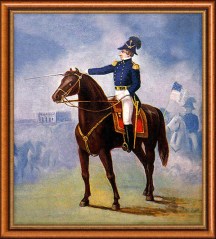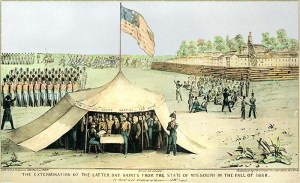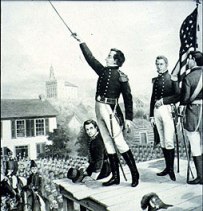by John Farkas
A DICTIONARY DEFINITION
Persecute…1 to afflict or harass constantly so as to injure or distress; oppress cruelly. esp. for reasons of religion, politics, or race. 2 to trouble or annoy constantly…
(Webster’s New World Dictionary, Third College Edition, Prentice Hall, 1988, 1991, 1994)
First let me clearly say that the persecution (using the #1 definition) of anyone is sinful and evil (Lev. 19:18; Matt 5:43, 19:19, 22:39 to name a few).
It is also wrong and dishonest to claim persecution when calm, quite, factual and non-harassing honest disagreement is voiced. I do not condone nor support the persecution of any people or group.
INTRODUCTION
This article will touch on three points relative to persecution and the Mormon Church:
1) Many LDS claim that the Mormon Church has been persecuted almost from its beginning in 1830. Is this the case?
2) What is not usually addressed is the opposite situation? Have Mormons persecuted others?
3) Were there extenuating circumstances that motivated persecution by both Mormons and non-Mormons?
To the best of my knowledge no in depth study has been completed on these subjects as a whole. There have been many good books on some aspect of items 1-3, but not as an overall in depth study.
POINTS TO CONSIDER
A hint of the complexity of this subject can be found in the so called persecution of Mormons that led to their communities leaving the Palmyra, New York area; Kirtland, Ohio area; Independence, Missouri area; Nauvoo, Illinois area and almost leaving their final settlement in the Salt Lake City area.
Can any thinking person not even be suspicious that perhaps there might be some other reason(s) than to say each and every one of the area the Mormons left had a large enough population of evil persecutors to force the move? How about the consideration of what the common denominator was in each of the geographical areas, a consideration of what each of the areas had in common – the population of Mormons?
Persecution in Kirtland, Ohio is usually mentioned but they fail to mention the illegal and fraudulent banking practices there and how the top leadership left the area and just escaped being arrested. Elder Dallin H. Oaks, of the Quorum of the Twelve Apostles, in speaking about the mistakes of Mormons said:
“Similarly, some mistaken decisions on Kirtland banking policies plagued the Saints for more than a decade. These financial difficulties were perhaps portended in the Lord’s warning to the Prophet Joseph Smith that ‘in temporal labors thou shalt not have strength, for this is not thy calling’ (D&C 24:9).”
( Ensign, “Sins and Mistakes”; October 1996, p. 63)

General Joseph Smith reviewing the Nauvoo Legion – which was larger than the Illinois State Militia.
Mormons are quick to point to Missouri Governor Bogg’s Mormon “Extermination Order” but fail to consider Sydney Rigdon’s “Salt Sermon” about trampling and hanging dissenters, the role of slavery, the historical events that led to Bogg’s order and the latter attempt on his life. What most people miss is the correct definition of “extermination” in the 1835 time period.
Webster’s Dictionary of 1828 under “exterminate” has:
“Literally, to drive from within the limits or borders. Hence, 1. To destroy utterly; to drive away….”
They are quick to claim persecution in Nauvoo, Illinois but fail to recognize the help non-Mormons gave to the Mormons when they left Missouri and moved into the Nauvoo area, how Mormons stole from the non-Mormons, counterfeiting of money and the political and economic issues.
Probably few consider that what they call persecution was punishment from the Lord (Doctrine and Covenants 101:2-7; 103:1-4: 105:2-5) Overshadowing all of these is the way frontier societies handled serious conflict.
For many Mormons, without their even being aware of it, persecution has reached the status of a myth. Frequently the accusation of persecution is given emotionally, but with little or no factual basis. It is all emotion and frequently used as a response to any information that is con-Mormon (as in pro and con), whether it is really persecution or not. They are quick to claim persecution in the present day, but fail to consider:
1) The bad things their own scriptures say about non-Mormons and the Bible (1 Nephi 14:10 and 13:26-29 in the Book of Mormon; Joseph Smith – History 1:18-20 in the Pearl of Great Price. These scriptures are distributed by the millions every year.)
2) The bad things past Mormon leaders have said about non-Mormons and the Bible (Rays of Living Light – Divine Authority by C. W. Penrose, page 1; and Rays of Living Light – Apostasy, by C. W. Penrose, page 3; published by the Church of Jesus Christ of Latter-day Saints, no date given; Journal of Discourses, 16:175-176, by Apostle Orson Pratt; Mormon Doctrine, 1958 edition, by Apostle Bruce R. McConkie, page 314-315; The Seer by Orson Pratt, page 205, 255.)
These same Mormons fail to consider that the Bible in Jude 1:3, 2 Timothy 1:7-9, 4:2; Ephesians 6:19-20 and Hebrews 5:14 says all mature Christians should present and defend their faith in Jesus Christ. We have the Apostle Paul’s examples in Acts 17:1-2, 17, 22, 18:4.
There is more on this subject under “Why Do We Oppose Mormonism?” which can be linked to off our home page. They fail to consider that some of the problems they call persecution were/are from the Lord because of the disobedience and transgressions of the “Saints” (Doctrine & Covenants 101:2-7; 103:1-4; 105:2-6).
MY CONCLUSIONS
The best conclusion I have been able to arrive at so far is that both Mormons and non-Mormons were seriously guilty of persecution.
Persecution, to the best I can see, has on both sides been driven by economic power, political power, evil people, retaliation and the way the frontier society of the day handled problems. It is a complex issue that one cannot begin to understand without a great deal of study. I do not claim to fully understand it. I am just a student of the subject.
Have the Mormons been persecuted? Yes.
Have non-Mormons been persecuted by Mormons? Yes.
Have there been extenuating circumstances for both sides? Yes.
Is it a complex subject? Very much so.
It is a subject that must consider economic power, politics power, the way the then frontier society handled problems, evil people and retaliation by both sides.
SOURCES OF INFORMATION ON WHAT IS CALLED “PERSECUTION” OF MORMONS AND THE MORMON CHURCH IN NEW YORK, OHIO, MISSOURI AND ILLINOIS
1. Nauvoo – Kingdom On The Mississippi, by Robert Bruce Flanders; Un. of Ill. Press; 1975; p. 1-22.
2. Nightfall At Nauvoo, by Samuel W. Taylor; Avon; 1971; p. 388-399.
3. The 1838 Mormon War In Missouri, by Stephen C. LeSueur; Un. of Missouri Press, 1987, all of it.
4. Mormon Enigma: Emma Hale Smith, by Linda King Newell and Valeen Tippets Avery; Doubleday: 1994: p. 62-94
5. Article: “Multiple Factors Led To Woes In Missouri;” Church News (by Mormon Church); p. 14; July 31, 1993.
6. Mormon Scriptures:
– Book of Mormon: 1 Nephi 14:10, 13:26-29
– Joseph Smith – History 1:18-20 (in the Pearl of Great Price)
– Doctrine and Covenants 101:2-7; 103:1-4: 105:2-6.
7. Women of Mormondom, by Edward W. Tullidge; 1877, 1975 printing; p. 289f, 376, 381, 395, 404.
8. Joseph Smith and The Beginnings of Mormonism, by Richard L. Bushman; Un. of Ill. Press; 1984; p. 159f.
9. The Mormon Hierarchy, by D. Michael Quinn; Signature Books; 1994; p. 88-89, 92-103, 469f, 620, 636.
10. Address To All Believers In Christ, booklet by David Whitmer in Richmond, Missouri; 1887; p. 27-28, 54-55.
11. The example of what was done to David Whitmer and Oliver Cowdery by Mormons; p. 37-39 of item 3 above.
12. A Scarter Man Than One of Them Was I Never Saw, booklet by Stephen C. LeSueur; Mormon Miscellaneous, Sandy, UT.
13. Sidney Rigdon: A Portrait of Religious Excess, by Richard S. Van Wagoner; Signature Books; 1994; p. 143-145, 192-208, 213-241.
14. The Mountain Meadows Massacre, by Juanita Brooks; Un. of OK Press; 1950; p. 3-9, 13-19.
15. The Journals of William E. McLellen; Ed. by Jan Shipps and John W. Welch; Un of Ill. Press; 1994; p. 9.
16. Salt Lake City Messenger (Tanner’s newsletter); Issue #88, May 1995; p. 6-10.
17. The Story of The Mormons, by William Alexander Linn; Macmillan Co.; 1902; p. vi, 122, 134-136, 154, 166-222, 258-261.
19. Cultures In Conflict, by John E. Hallwas and Roger D. Launius; Utah State Un. Press; 1995; p. 1-165.
About the Author
John R. Farkas (1932-2011) was a convert to Mormonism in 1975 and served in several callings up to and including Elder’s Quoruom President of the Rochester 1st Ward, New York Stake. In 1984 he left the LdS Church and became involved with Berean Christian Ministries where he served until his death. Mr. Farkas is the author of several books on Mormonism and other subjects which can be found on his Author’s page on Amazon. Beggar’s Bread is grateful that before he passed Mr. Farkas granted us the permission to republish the articles from his now defunct website.
John Farkas is of one the giants on whose shoulders we stand and to whom we owe a debt that we simply can never repay! We look forward to thanking him again in heaven for the example of his life and treasure of wisdom that he left behind for our benefit.
[Please note that while this article has been very lightly reformatted and re-paragraphed to improve overall legibility no content has been changed from Mr. Farkas’ original source article other than fixing a few typos and updating the names of a few books in the bibliography to more accurately reflect their full title of publication. — Fred W. Anson, editor]



I would add to the list:
20. The History of Reed Peck http://www.mormoninformation.com/reedpeck.htm
21. The History of John Corill http://www.boap.org/LDS/Early-Saints/Corrill-history.html
22. The Book of John Whitmer http://www.boap.org/LDS/Early-Saints/JWhitmer-history.html
LikeLike